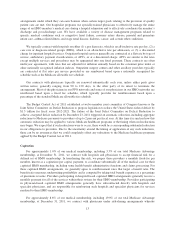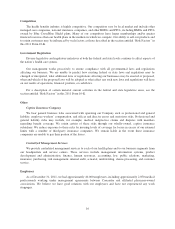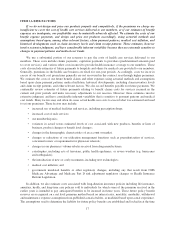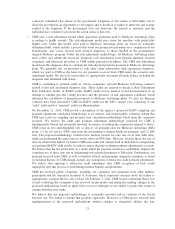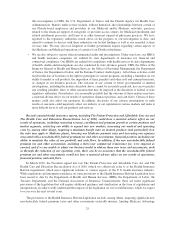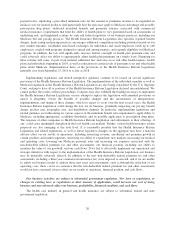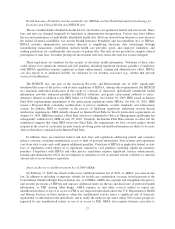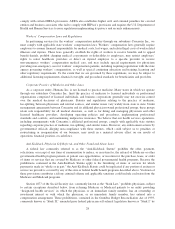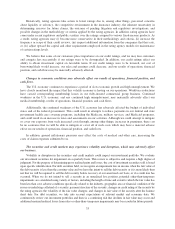Humana 2011 Annual Report Download - page 33
Download and view the complete annual report
Please find page 33 of the 2011 Humana annual report below. You can navigate through the pages in the report by either clicking on the pages listed below, or by using the keyword search tool below to find specific information within the annual report.contractor submitted false claims to the government. Litigation of this nature is filed under seal to
allow the government an opportunity to investigate and to decide if it wishes to intervene and assume
control of the litigation. If the government does not intervene, the lawsuit is unsealed, and the
individual may continue to prosecute the action on his or her own.
• CMS uses a risk-adjustment model which apportions premiums paid to Medicare Advantage plans
according to health severity. The risk-adjustment model pays more for enrollees with predictably
higher costs. Under this model, rates paid to Medicare Advantage plans are based on actuarially
determined bids, which include a process that bases our prospective payments on a comparison of our
beneficiaries’ risk scores, derived from medical diagnoses, to those enrolled in the government’s
original Medicare program. Under the risk-adjustment methodology, all Medicare Advantage plans
must collect and submit the necessary diagnosis code information from hospital inpatient, hospital
outpatient, and physician providers to CMS within prescribed deadlines. The CMS risk-adjustment
model uses this diagnosis data to calculate the risk-adjusted premium payment to Medicare Advantage
plans. We generally rely on providers to code their claim submissions with appropriate diagnoses,
which we send to CMS as the basis for our payment received from CMS under the actuarial risk-
adjustment model. We also rely on providers to appropriately document all medical data, including the
diagnosis data submitted with claims.
CMS is continuing to perform audits of various companies’ selected Medicare Advantage contracts
related to this risk adjustment diagnosis data. These audits are referred to herein as Risk-Adjustment
Data Validation Audits, or RADV audits. RADV audits review medical record documentation in an
attempt to validate provider coding practices and the presence of risk adjustment conditions which
influence the calculation of premium payments to Medicare Advantage plans. To date, six Humana
contracts have been selected by CMS for RADV audits for the 2007 contract year, consisting of one
“pilot” audit and five “targeted” audits for Humana plans.
On December 21, 2010, CMS posted a description of the agency’s proposed RADV sampling and
payment adjustment calculation methodology to its website, and invited public comment, noting that
CMS may revise its sampling and payment error calculation methodology based upon the comments
received. We believe the audit and payment adjustment methodology proposed by CMS is
fundamentally flawed and actuarially unsound. In essence, in making the comparison referred to above,
CMS relies on two interdependent sets of data to set payment rates for Medicare Advantage (MA)
plans: (1) fee for service (FFS) data from the government’s original Medicare program; and (2) MA
data. The proposed methodology would review medical records for only one set of data (MA data),
while not performing the same exercise on the other set (FFS data). However, because these two sets of
data are inextricably linked, we believe CMS must audit and validate both of them before extrapolating
any potential RADV audit results, in order to ensure that any resulting payment adjustment is accurate.
We believe that the Social Security Act, under which the payment model was established, requires the
consistent use of these data sets in determining risk-adjusted payments to MA plans. Furthermore, our
payment received from CMS, as well as benefits offered and premiums charged to members, is based
on bids that did not, by CMS design, include any assumption of retroactive audit payment adjustments.
We believe that applying a retroactive audit adjustment after CMS acceptance of bids would
improperly alter this process of establishing member benefits and premiums.
CMS has received public comments, including our comments and comments from other industry
participants and the American Academy of Actuaries, which expressed concerns about the failure to
appropriately compare the two sets of data. On February 3, 2011, CMS issued a statement that it was
closely evaluating the comments it has received on this matter and anticipates making changes to the
proposed methodology based on input it has received, although we are unable to predict the extent of
changes that they may make.
We believe that the proposed methodology is actuarially unsound and in violation of the Social
Security Act. We intend to defend that position vigorously. However, if CMS moves forward with
implementation of the proposed methodology without changes to adequately address the data
23


